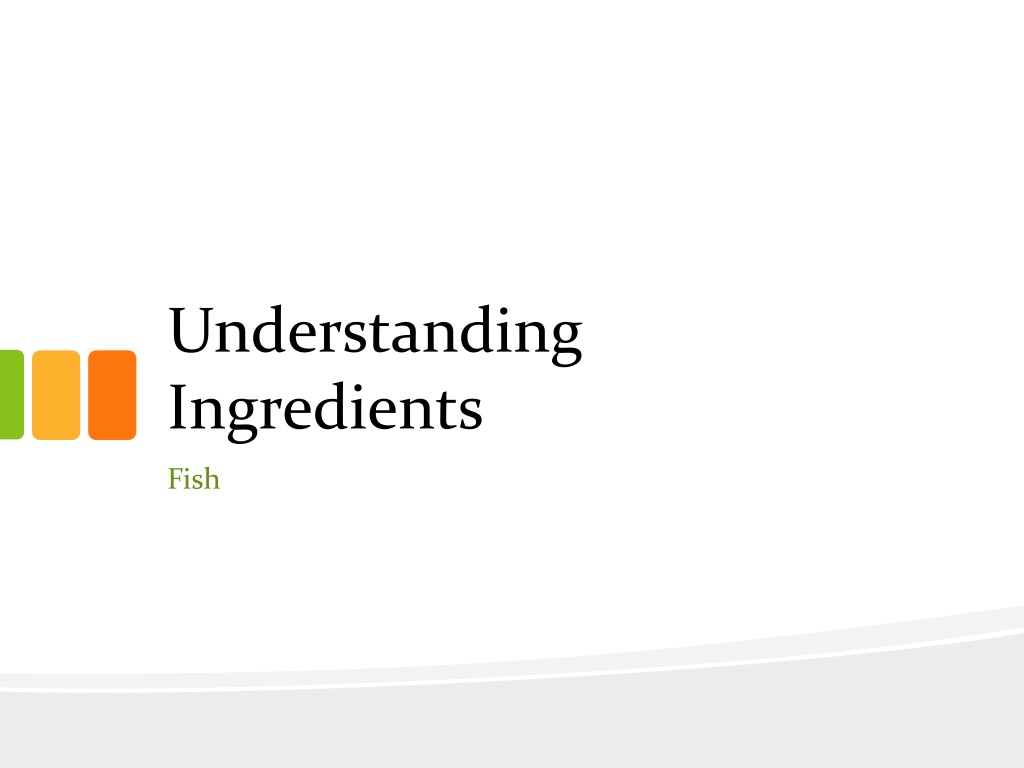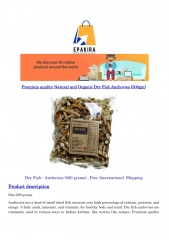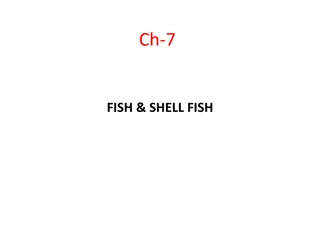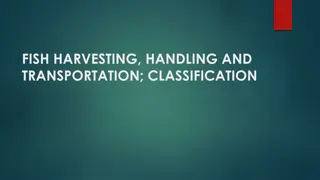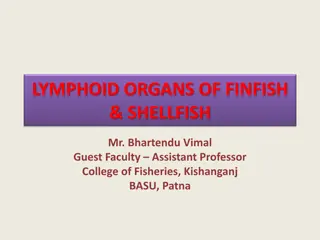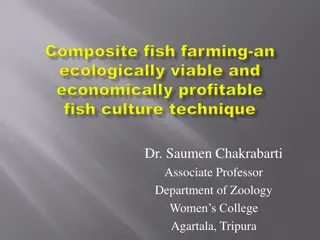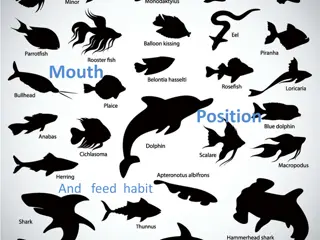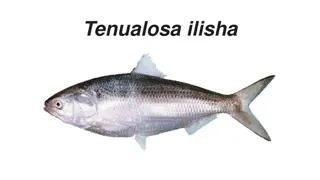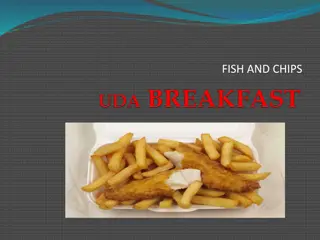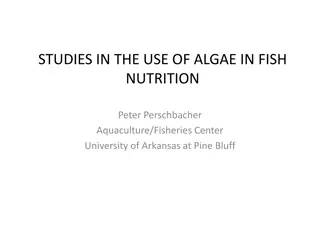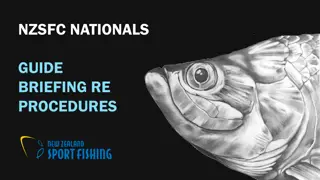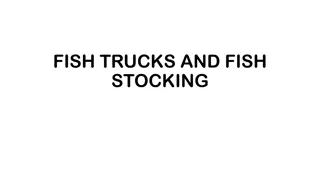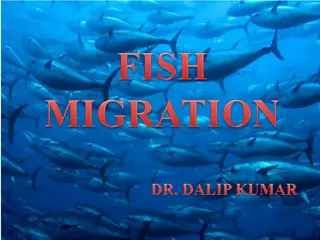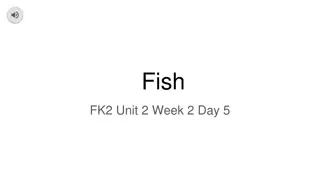Exploring Different Types of Fish: From Finfish to Shellfish
"Discover the diverse world of fish, including finfish and shellfish, with insights on their structures, nutritive value, cooking uses, and market availability. Learn about the various types of fish categorized by their living environment and fat content, as well as different forms and processed products in which fish are available."
Download Presentation

Please find below an Image/Link to download the presentation.
The content on the website is provided AS IS for your information and personal use only. It may not be sold, licensed, or shared on other websites without obtaining consent from the author. Download presentation by click this link. If you encounter any issues during the download, it is possible that the publisher has removed the file from their server.
E N D
Presentation Transcript
Understanding Ingredients Fish
Topics Types of Fish Structures of Fish Nutritive Value of Fish Choice and Storage of Fish Uses of Fish in Cooking / Diet 2
Types of Fish Fish is both edible finfish and shellfish obtained from marine and fresh water sources Fish is softer and flakier than either mammals or poultry, because muscle fibers exist as short bundles, which contain thin layers of connective tissue There are many ways to classify fish, e.g. to group them according to their place of living and their fat content 4
Types of Fish Groups of finfish according to their place of living: Sea Fish Freshwater Fish Lives in the sea and ocean Lives in rivers, lakes and ponds Grouper Sole Mackerel Pomfret Golden thread Carp Catfish Grass carp Grey mullet 5
Types of Fish Groups of finfish according to their fat content: Oily Fish White Fish Flesh of oily fish is often darker than that of white fish, flesh contains fat Flesh of white fish is white, it contains very little fat Cod Freshwater goby Dace Sole Grouper Mackerel Salmon Catfish Grass carp Carp 6
Types of Fish Shellfish has a hard shell. It is often grouped into two main types Crustaceans Mollusks With an outer shell and leg With an outer shell(s), without leg Crab Crayfish Lobster Shrimp Abalone Clams Mussels Oysters Scallops 7
Types of Fish Configuration of fish available in the market: Whole fish Fillet Cutlet Steak 8
Types of Fish Processed fish and fish products available in the market: Canned fish Sardine, tuna, salmon, dace Smoked fish Salmon Preserved fish and their products Salted fish, salted anchovy in oil, shrimp paste, oyster sauce Dehydrated fish Dried shrimp, dried oyster Processed fish Fish balls, surimi 9
Structure of Fish The muscle fibres of fish are similar to those of meat The fibres are arranged in flat flakes rather than in bundles There is only one type of connective tissue collagen, it softens and dissolves in cooking When fish is cooked, the flakes separate easily from each other and from the bone 11
Nutritive Value of Fish Protein The muscle fibres are composed of protein There is little difference between the different types of fish Both fish and shellfish are good sources of high biological value protein 13
Nutritive Value of Fish Fat Fish oils give a strong smell and taste The fat content is affected by the: type of fish white fish have no fat in the flesh, fat is only in the liver oily fish contain oil in the flesh method of cooking method of processing Fat content in shellfish is quite low 14
Nutritive Value of Fish Cholesterol Cholesterol in some shellfish is low (e.g. scallop), other is high (e.g. clam and mussel) Cholesterol in some shellfish (e.g. shrimp, crab, lobster) is mainly concentrated in the roe and head Both fish and shellfish are lower in saturated fat than other meats Carbohydrates Similar to mammals, carbohydrates is negligible in fish tissue 15
Nutritive Value of Fish Vitamins Oily fish is a good source of vitamins A and D White fish livers are not usually served and thus the vitamin is lost 16
Nutritive Value of Fish Minerals The muscle fibres of fish also contain minerals such as calcium, phosphorous, and iodine Calcium is present in canned fish where the bones have been processed to become soft and crumbly and can be eaten Salt (sodium chloride) is found in the flesh of seawater fish, it is also added during processing The mineral content of shellfish varies, e.g. Crabs and mussels are rich in calcium Clams and oysters are rich in iron Oysters are rich in zinc All types of shellfish are rich in iodine and phosphorous 17
Choosing Fish Fresh finfish should have the following features: Bright, shiny and plentiful scales Clear and bulging eyes Bright red gills Firm and springy flesh 19
Choosing Fish Live shellfish should have the following features: Active and full of movements Crabs and lobsters should feel heavy in weight, crabs should not be watery when opened Prawns and shrimps should have clear but not blackened shells, the heads should be firmly attached to the bodies Single shell shellfish without legs should have tightly closed shells Do not buy shellfish which has an unpleasant smell 20
Storing Fish Fresh finfish Cook and eat the fish on the day it is bought If it is to be kept for 2 to 3 days, remove the internal organs, clean the fish thoroughly, put it in a polythene bag and store it in the refrigerator. Frozen finfish Keep in the freezer Never refreeze thawed fish Canned fish Keep in a dry cupboard 21
Storing Fish Wrap and store in the refrigerator Cook and eat the fish on the day it is bought Fresh shellfish Store fresh shrimps and prawns in polythene bag Keep in the freezer Never refreeze thawed shellfish Frozen shellfish 22
Uses of Fish in Cooking / Diet 23
Uses of Fish in Cooking / Diet Fish may be steamed, boiled, grilled, baked or fried Fish can be used as an ingredient in soups, main courses, snacks Examples of fish-based dishes: Shrimp on Toast Fish Cakes Fish Balls Fish burger Fish pie 24
References Provost, J., Kelly, B., Bodwin, J., & Wallert, M. (2016). The Science of Cooking. John Wiley & Sons. Vickie A. Vaclavik, Elizabeth W. Christian. Essentials of food science. New York, NY: Springer, c2008. 25
